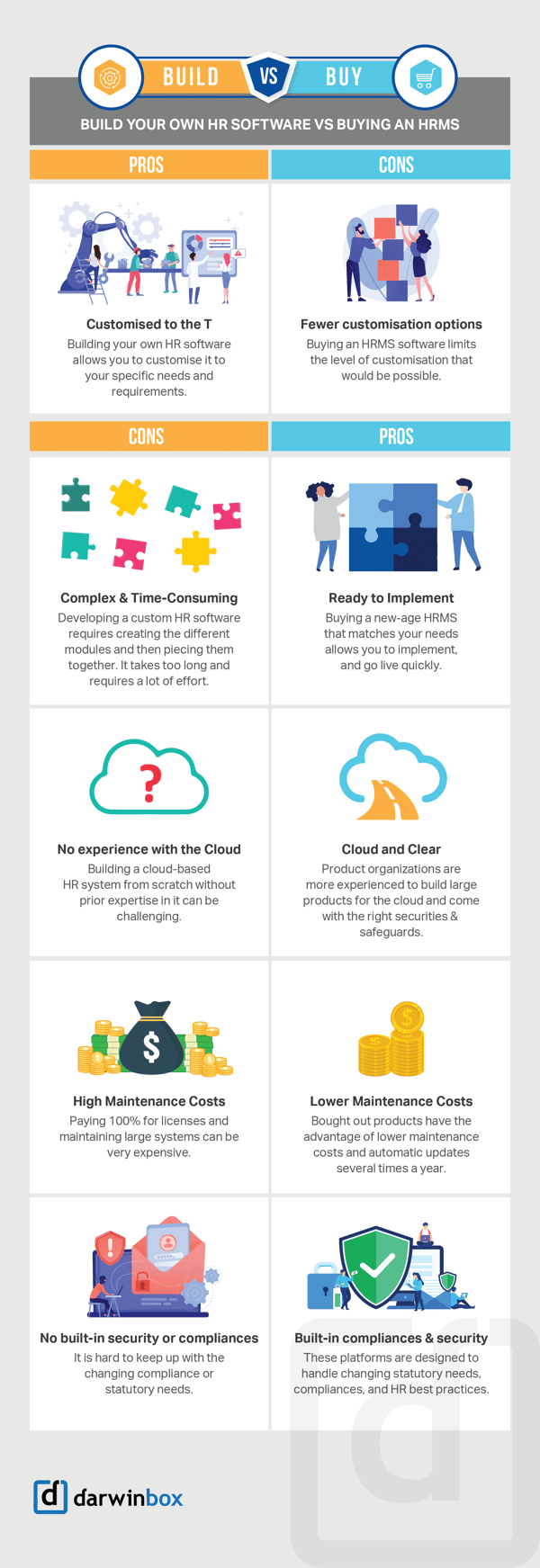

So you have set a vision for HR Digital Transformation and have completed your internal audits and assessments with a detailed plan on things to be done. But who do you partner with to execute this?
The technology could be built in-house or purchased from third-party vendors. With the number of technology solution providers today, there is also a choice to implement specialised solutions for specific functions or processes from best-of-breed providers or opt for end-to-end service providers offering integrated solutions. The end product could be hosted on-premise or on the cloud. Each of these decision paths is critical to evaluate before selecting the right technology partner.
Here’s a look at the critical choices and the consideration factors in assessing each of them:
Cloud vs. On-Prem

- Implementation speed:
On-premise solutions require an in-house installation of hardware and systems before going live, whereas cloud solutions can be accessed quicker. Third-party cloud solution providers offer access through apps and interfaces that users can easily download across the organisation for quicker implementation.
If time is a constraint, cloud solutions could be a better choice as the systems can go live faster than setting up and customising an on-premise HRMS.
-
Adoption and Maintenance:
Cloud HRMS systems are more intuitive and user-centric in design, reducing time required to train personnel to increase adoption. This makes integration within existing systems easier and seamless to adapt. Here’s how one of India’s top Pharmaco’s benefitted from moving from an On-premise solution to Cloud HRMS.
Additionally, on-premise HRMS would need frequent manual upgrades and maintenance by IT personnel, affecting the team’s overall productivity. As opposed to a cloud HRMS solution where the service provider takes care of periodic maintenance and ensures real-time upgrade of the systems without any intervention needed from your team.
- Data Confidentiality:
An on-premise HRMS offers control as the data is safely secured within your data warehouses. Several companies within highly regulated industries handling sensitive data might be required to pursue this path to stay compliant with the existing laws of the land.
With cloud solutions, the data is managed by the third-party service provider. However, these companies are continually enhancing their standards to adhere to the best security measures to safeguard sensitive data. Today, cloud solutions adopt the latest and most advanced technologies to address data privacy by providing multi-layered security to meet even the most stringent compliance standards across industries.
-
Costs incurred:
Cost is one of the most significant benefits of adopting cloud solutions. Using cloud HRMS, you can “pay as you use” as they are recurring licensing fees instead of capital expenditure. With on-premise HRMS, you have to bear upfront capex for the hardware and the software and substantial configuration and implementation costs.
However, the pay as you use model for cloud HRMS adds up over time as organizations scale, increasing its total cost of ownership over time compared to on-premise HRMS.
The HRMS solution you choose to deploy should align with your overall business strategy while considering available resources, budgets, timelines, and regulatory norms.
Build vs. Buy

The next consideration with HR transformation projects is whether to build the HRMS or buy it.
Building a custom HR software offers more control to customize the solution to meet your unique needs. If built right, the proprietary code and system could give you an edge over your competitors.
On the contrary, buying a packaged HRMS solution is inexpensive, easy to implement, and faster to go-live. Intuitively built for the end-user, the outcome is guaranteed to meet its purpose when you buy time-tested off-the-shelf solutions.
However, here are a few critical aspects you must consider before choosing either path:
- Budget:
Building from scratch requires investment in time, effort, and money for any organisation. Most companies do not have big budgets to accommodate building enterprise-level software solutions. If budget is a constraint, buying need-based licenses might be lighter on the P&L than opting to build it.
- Opportunity Cost:
When you allocate resources to building a solution, are you taking employees away from their most meaningful work? What could the additional resources be spent on? Your decision to build should not be detrimental to other core projects. However, if your organisation has the talent in-house that can be spared to make this happen, you could consider leveraging the talent to build the right product.
With buying a solution off-the-shelf, there is no need to consider opportunity costs as it requires limited involvement from your internal resources to integrate the solutions.
- Time Horizon:
It takes time to build a system from scratch. If the time horizon is short and the market already has the right solution to match your needs, it makes more sense to buy, implement, and go live quickly.
However, if time is not a constraint, you could focus on carefully customising and building a solution that caters to your business’s needs.
- Quality:
It is crucial to assess your in-house team’s capability to build a solution that meets your evolving business needs. Your teams must be capable of delivering agile solutions that are futuristic and scalable as your business grows.
In the case of off-the-shelf HRMS solutions, there are no surprises as the quality is already assured, as you can see the demo of the final solution before choosing to implement it within your organization.
- Security:
If data security is a concern and control over data is of primary importance, then building it might be more effective than buying it.
Alternatively, you could assess the available solutions for the security measures in-built to avoid a breach of data and cyber threats. You could choose to buy once convinced that you trust the technology partner and ensure your data is secure and protected.
The build vs. buy decision has long term ramifications and must be carefully considered before reaching the final decision.
Best-of-breed vs. End-to-End

End-to-end/ Fully integrated software is essentially a one-size-fits-all solution. It offers a package with several pre-integrated modules covering a range of functions and requirements. Best of breed, on the other hand, provides specialised solutions for specific purposes.
End-to-End solutions offer a holistic approach to solve for critical business requirements. These are integrated solutions that automatically link the databases involved usingkey fields. The main benefit of these solutions is that there’sno need for integration, and there’s onlyone supplier your team needs to deal with. With only one vendor and one product in the equation and all the data in one place,operations and user adoption of integrated solutions are relatively easy.
However, these solutions are difficult to customise and might have limitations on features catering to organisation-specific processes. You might have to compromise on your workflows to make them fit into the solution.It also creates heavy reliance on a single vendor impacting flexibility. The company remains at the mercy of the sole vendor when faced with downtime or system constraints.
Whereas, best-of-breed solutions provide high levels of customisation to adapt to the organisation’s specific processes. These specialised solutions have in-depth features to address all the needs of a given HR function. With dispersed vendors, organisations are not dependent on a single vendor to service all their system requirements.
However, they may not integrate with other existing systems within the organisation, making it difficult for the management to access a single view of critical data or processes. It could also become difficult for HR teams to coordinate multiple vendors when support is required.
Put on your thinking caps and go back to the whiteboard to assess these critical decision paths before choosing the right technology partner in your transformation journey.
We’ve also created a ready-to-use Enterprise HRMS RFP template that you can use to evaluate and find the HR Tech partner best suited for your organisation’s specific needs.




Speak Your Mind